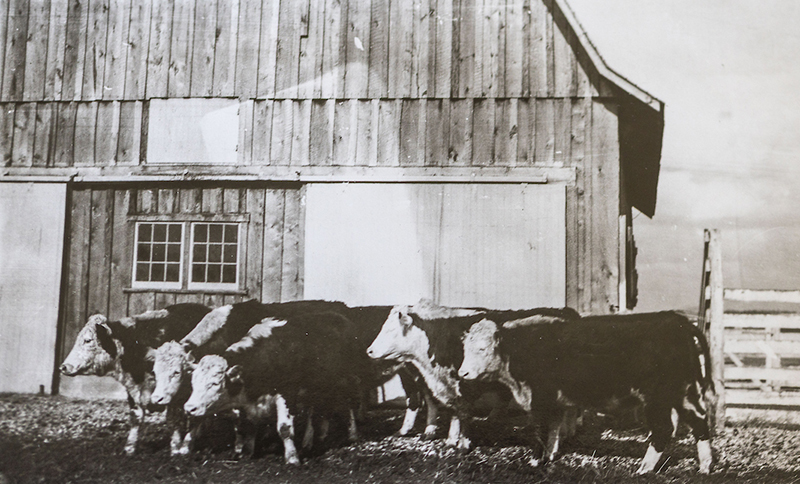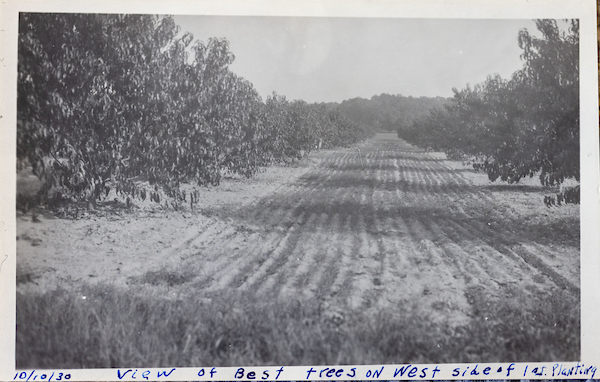3-History-1930s
Drought and Depression (1930s)
Economic struggles and drought marked the 1930s. As the financial depression that started in late 1929 continued seemingly without end, Lowry’s reports to Dean Cooper increasingly referred to tight budgets that precluded improvements in the farm.
Lowry’s meticulous reports to Dean Cooper throughout the 1930s document the effects of the drought and depression on the farm. In December 1930, Lowry wrote to Cooper, “The 1930 drought situation is so well known by everybody in Kentucky that no lengthy comments need herein be recorded.”
By late July of that year, Lowry reports, two silos were filled to salvage corn, none of which had formed ears because of the intense heat and drought. He also noted that because the pastures were dry enough to burn off, they had fed the dairy herd silage that had been ensiled in 1925. Lowry also said that “alfalfa saved the day.” A field day planned for August was cancelled due to the fire hazard presented by the drought.
Budget cuts in 1932 reduced the station’s funding by $5,000, limiting new research projects and construction.
Research and Education Continues
New initiatives, however, were developed during the decade that demonstrated not only the increasing sophistication of the research but also a wide array of research topics.
Disease control research on dark tobacco, notably resistance to mosaic virus and black root rot, began early in the decade. A dark tobacco variety resistant to black root rot had been developed and was being tested by 1936. Research on the merits of different curing methods began in 1936, involving a comparison of a new “soft curing” method (low temperature, high humidity) with the modified old method (high temperatures, low humidity).
The corn variety trials conducted each year since the substation’s inception added hybrid varieties to the trials during the decade. Notably, Lowry in 1936 reported that several corn hybrids developed by the Experiment Station yielded 20 percent more than conventional, open-pollinated varieties.

A steer feeding test also began in the early 1930s, and by 1937, they started comparing protein sources in rations.
Horticulture research intensified in 1938 when W.D. “Army” Armstrong was hired as the first research scientist stationed at the site. His assignment at the farm was to conduct research and collaborate with local horticultural enterprises. Twenty-two experimental projects were conducted this year.
TVA Cooperative Program
With the formation of the Tennessee Valley Authority in 1933 came an agreement to develop cooperative programs with the land-grant universities in the seven-state valley region. A TVA project was initiated at the substation in 1934, and the cooperative program was enhanced in 1935 with the hiring of Charles Wyatt as an area agronomy specialist, headquartered in Mayfield. Wyatt’s work involved demonstrations on farms and at the substation in Princeton, marking a first attempt to use whole-farm demonstrations as educational tools.
Catch a glimpse into 1930s farm work in Kentucky.

Station Milestones
1930
- The legislature appropriated $10,000 for the construction of buildings on the farm, including a building with office space, a laboratory, a cold storage facility, and a meeting room that could accommodate 400 people on folding chairs.
- Beef cattle barn and silo built
1931
- Construction on the service building is completed.
- The peach trees planted on the farm began to produce, and it was reported that the first carload of peaches was shipped from Princeton to Lexington.
1932
- The first short course was held over two days in February of that year and became an annual event until 1942, with attendance averaging from 200 to 300 persons.
- The station hosted the 4-H Club Leaders Conference and the Kentucky Farm Bureau Roundup, attracting 500 visitors.
- The tall fescue, from seed acquired by E.N. Fergus from the W.M. Suiter farm in Menifee County, was first seeded at the station.* AGR-108
1933
- This is the first mention of a tractor on the farm.
1935
- The station was designated as a temporary 4-H club campsite.
- A tobacco barn and two brooder houses have been built.
1936
- The dairy barn burned and was rebuilt.
1938
- UK horticulture research scientist W.D. Armstrong is headquartered at Princeton.
1939
- Seed from the tall fescue growing at the station was distributed by W.C. Johnstone for trials by interested farmers. *AGR-108
